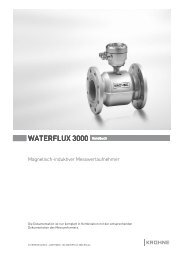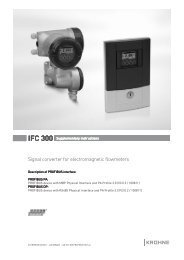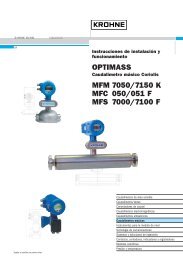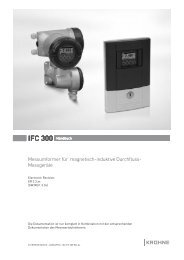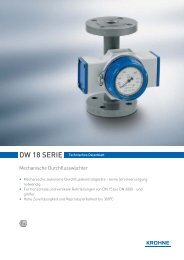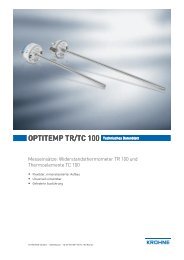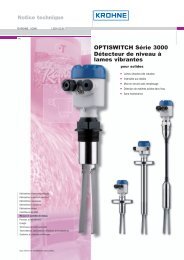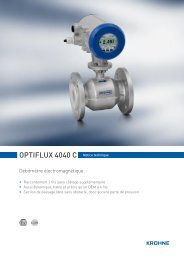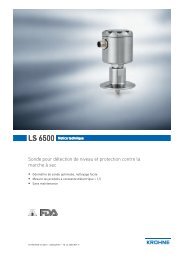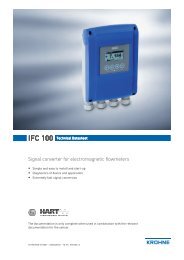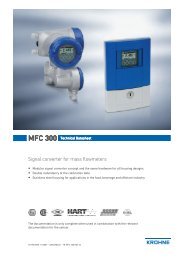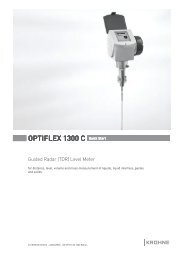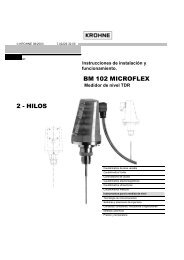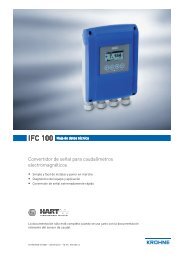Fundamentals of profibus pa networks - Krohne
Fundamentals of profibus pa networks - Krohne
Fundamentals of profibus pa networks - Krohne
You also want an ePaper? Increase the reach of your titles
YUMPU automatically turns print PDFs into web optimized ePapers that Google loves.
© KROHNE 04/2001 7.02359.21.00<br />
GR / PRINTO<br />
<strong>Fundamentals</strong> <strong>of</strong><br />
Pr<strong>of</strong>ibus PA<br />
Networks<br />
Dipl.-Ing. Günter Pinkowski<br />
KROHNE Messtechnik GmbH & Co. KG<br />
Duisburg, 2000
PROFIBUS PA<br />
Contents:<br />
Page<br />
1 Introduction 3<br />
2 PROFIBUS – General 4<br />
2.1 PROFIBUS variants 4<br />
2.2 Typical PROFIBUS-DP/PA network 4<br />
3 PROFIBUS-PA – the standardized solution 5<br />
4 PROFIBUS-PA – the economical solution 6<br />
5 PROFIBUS-PA – planning 6<br />
5.1 Mode <strong>of</strong> operation 6<br />
5.2 Rules for interconnecting devices in hazardous areas 8<br />
5.3 Segment coupler 9<br />
5.4 Fieldbus cable types 10<br />
5.5 Number <strong>of</strong> devices per fieldbus segment 12<br />
5.6 The Cycle time 13<br />
5.7 Remote I/O and redundancy 13<br />
5.8 Connection technique, bus termination, repeater 14<br />
5.9 Shielding and grounding 16<br />
6 PROFIBUS-PA – projectplanning 17<br />
7 PROFIBUS-PA – operator control <strong>of</strong>field devices 19<br />
8 PROFIBUS-PA – device pr<strong>of</strong>ile B 19<br />
9 PROFIBUS-PA – technical data <strong>of</strong> KROHNE devices 21<br />
10 Components from other manufacturers 22<br />
Source documentation 23<br />
Notes:<br />
● SIMATIC PDM and HW-Config are trademarks <strong>of</strong> Siemens<br />
● Data provided by other manufacturers are also quoted. All information given in this<br />
brochure is understood to be non-binding and designed purely as an aid to engineers<br />
planning a potential PROFIBUS-PA system.<br />
However, technical progress will undoubtedly cause these specifications to change<br />
in the course <strong>of</strong> time.<br />
● In case <strong>of</strong> doubt, the relevant directives and standards are always applicable.<br />
● No liability whatsoever shall be accepted in respect <strong>of</strong> any and all details given in<br />
this brochure.<br />
2 PROFIBUS PA
1 Introduction<br />
The 0/4...20mA interface is nowadays still the standard equipment used to link up sensor<br />
and actuator systems with, for example, a digital control system. The advantage <strong>of</strong> this interface<br />
lies in the fact that it is in widespread use and allows relatively easy interchangeability<br />
<strong>of</strong> devices supplied by different manufacturers.<br />
In this age <strong>of</strong> communications technology, one-way communication, i.e. transmission <strong>of</strong><br />
measured values from the field device to the control system, for example, is no longer<br />
sufficient to meet the requirements for pr<strong>of</strong>itability and high flexibility demanded in many<br />
industrial sectors.<br />
The so-called smart technology was introduced as far back as 1983 to enable the measuring<br />
ranges <strong>of</strong> differential-pressure transmitters to be changed from the control room.<br />
Today, the HART® technology has developed into a quasi-standard for many sectors and is<br />
indeed gaining more and more significance.<br />
The true benefits <strong>of</strong> serial digital communications technology, however, can only be exploited<br />
in conjunction with a standardized open system fieldbus. Here, the PROFIBUS presents<br />
itself with its PA variant (Process Automation), which has been optimized to suit process<br />
engineering requirements.<br />
In addition to more cost-effective instrumentation, the PROFIBUS-PA is characterized by<br />
substantially greater functionality. The PA pr<strong>of</strong>ile, referred to the basic functionality <strong>of</strong> the<br />
field devices, is designed to meet the demand for interchangeability <strong>of</strong> devices from<br />
different vendors, as naturally also the possibility <strong>of</strong> service in hazardous areas and the<br />
feeding <strong>of</strong> so-called two-wire devices.<br />
For further information on communications, please ask for the KROHNE brochure<br />
"Communications Engineering".<br />
General Purpose<br />
Automation<br />
- Large variety <strong>of</strong> applications<br />
- Multi-master communication<br />
Factory<br />
Automation<br />
- Plug and play<br />
- Efficient and cost effective<br />
Process<br />
Automation<br />
- Powering over the bus<br />
- Intrinsic safety<br />
Figure 1<br />
PROFIBUS PA 3<br />
1
2<br />
Verwendete Formelzeichen<br />
2 PROFIBUS – General<br />
The PROcess Field BUS (PROFIBUS) is the outcome <strong>of</strong> a joint project founded in 1987 by<br />
the com<strong>pa</strong>nies <strong>of</strong> Bosch, Klöckner-Möller and Siemens. In all, 13 com<strong>pa</strong>nies and 5 universities<br />
were involved in the project. PROFIBUS allows exchange <strong>of</strong> data between devices made<br />
by different manufacturers without the need for special adaptation <strong>of</strong> the interface.<br />
The specifications <strong>of</strong> the PROFIBUS are described in detail by Layers 1, 2 and 7 <strong>of</strong> the<br />
ISO/OSI reference model. Information on the reference model and the various communication<br />
techniques are also given in the brochure "KROHNE Communications Engineering".<br />
PROFIBUS has to date already acquired a considerable share <strong>of</strong> the market and is Europe's<br />
fieldbus No. 1. Worldwide, more than 1000 com<strong>pa</strong>nies with over 1200 products are represented<br />
in the umbrella organization <strong>of</strong> PROFIBUS International. PROFIBUS is a multi-master<br />
system. Controlled bus access is regulated by a hybrid bus access method, i.e. the token<br />
<strong>pa</strong>ssing method is used for the distributed system and the master/slave principle for the<br />
centralized system.<br />
2.1 PROFIBUS variants<br />
Since the PROFIBUS is used in both production and process automation and also for<br />
building services management systems, variously optimized variants <strong>of</strong> the PROFIBUS are<br />
available, as shown in Figure 1. FMS stands for Fieldbus Messaging Specification, DP for<br />
Distributed Peripheral, and PA for Process Automation.<br />
2.2 Typical PROFIBUS-DP/PA network<br />
The automation structure shown in Figure 2 illustrates one <strong>of</strong> a number <strong>of</strong> possible interconnections.<br />
Some useful explanations now follow on the basis <strong>of</strong> this diagram:<br />
The Class 1 master is the automation system and performs the open-loop and closed-loop<br />
functions. It transmits measured values and status cyclically from all e.g. connected<br />
measuring devices using the so-called cyclic services. With extended DP functionality, one<br />
or several Class 2 masters (the engineering station or the operator's station) are basically<br />
ca<strong>pa</strong>ble <strong>of</strong> accessing all <strong>pa</strong>rameters and functions <strong>of</strong> the connected PA devices by means<br />
<strong>of</strong> the so-called acyclic services.<br />
Access can also be made to existing HART-ca<strong>pa</strong>ble devices. Accordingly, these devices can<br />
be connected e.g. via a distributed interface module (e.g. ET200M from Siemens) to the<br />
PROFIBUS-DP and be incorporated with complete functionality in the engineering or operator's<br />
station.<br />
A further point to be borne in mind is that the baud rate in the DP network depends upon<br />
the segment coupler/link used (see "Segment coupler").<br />
4 PROFIBUS PA
PROFIBUS-PA<br />
KR O HN E<br />
1 2 3 4 5 6<br />
Operating tool<br />
Master class 2<br />
DP/PA-Coupler PA-Link<br />
PROFIBUS-DP up to 12 Mbit/s<br />
PROFIBUS-PA<br />
kg/h<br />
1000<br />
900<br />
800<br />
KROHNE<br />
700<br />
600<br />
500<br />
400<br />
300<br />
200<br />
100<br />
RP<br />
H250<br />
kg 7 8 63<br />
2 0<br />
SN 586 677/01-03<br />
MC H250/RR/ M9/K2 /ESK- Z<br />
C K25.2 1.4571<br />
F CIV 25 1.4571<br />
MD 1997<br />
C2 H50H<br />
D 0.93 kg/l<br />
V 2.5 mPa.s<br />
T 23.5 C<br />
P 0.4 MPa<br />
FIA 1025<br />
Analogue<br />
I/O Module<br />
Control system (PLC)<br />
Master class 1<br />
3 PROFIBUS-PA – the standardized solution<br />
One <strong>pa</strong>rt <strong>of</strong> the european Fieldbus standard EN50170 and <strong>of</strong> the International fieldbus<br />
standard IEC 61158 is PROFIBUS. PROFIBUS-PA therefore is integrated as well.<br />
The physical layer <strong>of</strong> the PROFIBUS-PA variant, in addition, conforms to the IEC 61158-2<br />
Standard which is also used for the Fieldbus Foundation fieldbus (see Table 1)<br />
Baud rate<br />
Physical layer acc. to IEC 61158-2,<br />
Variant H1<br />
31.25 kbit/s<br />
Topology line or tree<br />
Power via the bus DC supply possible<br />
Intrinsic safety possible<br />
No. <strong>of</strong> devices max. 32 (non-“Ex“)<br />
approx. 9 (Explosion Group IIC)<br />
approx. 23 (Explosion Group IIB)<br />
Cable length max. 1900 m<br />
Spur length max. 120 m per spur Non-Ex, 30 m per spur Ex<br />
(see Section on “Fieldbus cable types“)<br />
Redundancy possible<br />
4...20mA<br />
4 PROFIBUS-PA – the economical solution<br />
There are basically two important reasons for adopting the fieldbus technology as the<br />
standard interface in the near future: substantially improved functionality combined with<br />
reduced installation and operating costs.<br />
Figure 2<br />
Table 1<br />
PROFIBUS PA 5<br />
3
4/5<br />
Functional advantages<br />
● High resolution <strong>of</strong> the measured value<br />
● Transmission reliability<br />
● Multifunctional field devices<br />
● Corrective functions in the field device<br />
● Distributed intelligence<br />
● Support on the maintenance side<br />
● Self-test functions and diagnostic ca<strong>pa</strong>bilities<br />
● Standard, vendor-independent operator control<br />
● Reduced requirement for stockable devices (due to wide measuring ranges)<br />
Economic benefits<br />
Two areas are considered in which users can achieve substantial cost savings by using the<br />
field bus technology. This has been shown by a survey carried out by several NAMUR member<br />
firms. The cost blocks are:<br />
Installation costs<br />
Cost calculations were based on a system with 400 input and output signals, <strong>of</strong> which<br />
approx. 50% had a direct bus connection and the other 50% were connected via a field<br />
multiplexer. The cost categories considered were hardware (racks, subracks, etc,), assembly<br />
(assembly material and wage costs), and planning for wiring, power supply and rack equipment.<br />
Com<strong>pa</strong>red to a conventional system <strong>of</strong> the same size, costs for the fieldbus system<br />
worked out at approx. 43% less! Not included were the field devices and the control<br />
system. A different user survey arrived at a cost reduction <strong>of</strong> approx. 25% for the complete<br />
automation <strong>pa</strong>ckage. Of course, potential savings will depend essentially on local<br />
conditions. The first systems in operation, however, basically confirm that figure.<br />
Maintenance costs<br />
This cost group proved much more difficult to estimate. The outcome undoubtedly involves a<br />
wider range <strong>of</strong> variation. Nevertheless, cost reductions were also achieved here. Due to the<br />
numerous support possibilities in maintenance (e.g. central error reporting station, error<br />
identification and diagnostic functions, maintenance requests, automatic documentation,<br />
fewer replacement devices and fewer operator errors), potential savings proved out at<br />
approx. 24%.<br />
5 PROFIBUS-PA–planning<br />
5.1 Mode <strong>of</strong> operation<br />
In the PROFIBUS-PA, information and, if necessary, power supply are routed via a two-wire<br />
line. Use in both hazardous and non-hazardous areas is envisaged with the PA variant. For<br />
hazardous duty the PA bus including all connected devices must be designed in Intrinsic<br />
Safety "i" type <strong>of</strong> protection. For field devices requiring a se<strong>pa</strong>rate supply, so-called<br />
“fourwire devices", the fieldbus connection at least must be designed in Intrinsic Safety.<br />
Accordingly, both device types, two- and four-wire devices, can readily be coupled together.<br />
Together with the Physikalisch Technische Bundesanstalt (PTB), who on behalf <strong>of</strong> KROHNE<br />
6 PROFIBUS PA
3. Magnetisch-induktive Radar-Füllstandsmesssysteme<br />
Durchflussmesser (MID)<br />
But first to illustrate the mode <strong>of</strong> operation according to the FISCO model, see also Figure.<br />
3.(and other com<strong>pa</strong>nies) developed the so-called Fieldbus Intrinsically Safe COncept (FIS-<br />
CO in short), it was demonstrated that taking into account a number <strong>of</strong> boundary conditions<br />
the customary calculations for intrinsically safe circuits can be replaced by a more simplified<br />
approach.<br />
Ethernet TCP/IP<br />
Ex e<br />
Ex i<br />
Only the so-called segment coupler is ca<strong>pa</strong>ble <strong>of</strong> supplying power to the line. All other<br />
users (field devices and bus termination) only take up power. Each field device should on<br />
average have an input <strong>of</strong> at least 10mA. This is the so-called base current. Ideally, it should<br />
not take up more than 10mA as otherwise it may prove necessary to reduce the number <strong>of</strong><br />
connectable devices.<br />
The bus must be terminated at both ends. At one end the termination is included in the<br />
segment coupler. At the other end a termination module is connected which requires<br />
suitable hazardous duty approval for harzadous area. The physical interface <strong>of</strong> the<br />
PROFIBUS-PA and the applied FISCO model are in conformity with IEC Standard IEC 61158-2.<br />
I per Fielddevice<br />
19 mA<br />
10 mA<br />
1 mA<br />
Base<br />
Current<br />
PROFIBUS-DP<br />
Segmentkoppler<br />
PROFIBUS-PA<br />
Ex i<br />
Max. 10 Geräte<br />
(IIC)<br />
Max. 31 Geräte<br />
FDE<br />
current e.g.= 7 mA<br />
1 0 1 1 0 1 t<br />
The communication signal, a Manchester-coded BI-L phase signal (see Figure 4), is obtained<br />
by suitable modulation <strong>of</strong> the current within the limits <strong>of</strong> +/- 9mA, referred to the base current.<br />
Figure 3<br />
Figure 4<br />
PROFIBUS PA 7<br />
5
5<br />
3. Radar-Füllstandsmesssysteme<br />
The so-called Fault Disconnection Electronics (FDE) has been defined to prevent one field<br />
device, also in the case <strong>of</strong> a fault, from immobilizing the entire bus. This limits the maximum<br />
input <strong>of</strong> continuous current. The fault current, which is the continuous current over and above<br />
the base current (see Figure 4) that the device can take up in the case <strong>of</strong> a fault, has however<br />
not been defined to date. There are indications that the fault current is to be limited to<br />
max. 9 mA. Hence, the planning engineer is required to consider all potential devices in a<br />
PA segment in terms <strong>of</strong> fault currents and include the maximum possible fault current in his<br />
calculations. See also "Number <strong>of</strong> devices per fieldbus segment".<br />
The classic practice when planning an intrinsically safe circuit is to infer from the details <strong>of</strong><br />
the feeder unit the maximum concentrated ca<strong>pa</strong>citances and inductances that are allowed<br />
for connection <strong>of</strong> a field device and the connecting cable. As already mentioned, a considerably<br />
simplified approach was found by the PTB studies in conjunction with the FISCO<br />
model. A special feature noticeable with the segment coupler (incl. bus feed unit) is that the<br />
normally given limit values for the maximum allowable external inductance Lo and ca<strong>pa</strong>citance<br />
Co are not listed for the supply circuit. The investigations have shown that when the<br />
line <strong>pa</strong>rameters given in Table 2 are conformed to, the lines themselves have no negative<br />
consequences on explosion probability and so the customary calculation methods can be<br />
dispensed with. A system certificate for a complete PA segment is also not required,<br />
provided all components <strong>of</strong> a segment have FISCO certification. The following Table lists<br />
the limits <strong>of</strong> the <strong>pa</strong>rameter ranges for application <strong>of</strong> the FISCO model for EEx ib IIC/IIIB<br />
and EEx ia/IIC, which result from the PTB studies and acceptable extrapolations in terms <strong>of</strong><br />
safety requirements.<br />
Table 2 EEx ib IIC/IIB<br />
Feed unit: Approx. square-wave output<br />
characteristic<br />
Uo = 14...24V (safety peak value)<br />
Line: R’ = 15...150 Ohm<br />
L’ = 0,4...1 mH/km<br />
C’ = 80...200 nF/km (incl. shield)<br />
No restrictive safety requirements up to<br />
5000m cable length. Limited to 1900m by<br />
IEC 61158-2.<br />
EEx ia/IIC<br />
Feed unit: Trapezoidal output characteristic<br />
Uo = 14...24V (safety peak value)<br />
Line: R’ = 15...150 Ohm<br />
L’ = 0,4...1 mH/km<br />
C’ = 80...200 nF/km (incl. shield)<br />
No restrictive safety requirements up to<br />
1000m cable length.<br />
5.2 Interconnection rules for hazardous-duty devices<br />
Before detailed planning <strong>of</strong> a PROFIBUS segment can proceed, a few definitions need to<br />
be made for systems in hazardous areas. The definition <strong>of</strong> the Explosion Group is especially<br />
important in terms <strong>of</strong> the maximum number <strong>of</strong> connectable devices per segment. Explosion<br />
Group IIB or IIC is to be defined here. The required category "ia" or "ib" also needs to be<br />
defined, which likewise has crucial effects on the planning <strong>of</strong> the fieldbus segment.<br />
The rules given in the following apply to PTB's FISCO model. Differing rules may apply in<br />
other countries.<br />
Interconnection <strong>of</strong> "FISCO devices" only.<br />
If the degree <strong>of</strong> freedom opened up by the PTB with the FISCO model is to be utilized when<br />
planning the PROFIBUS-PA in hazardous areas, then all components connected to an "Ex"<br />
PA segment must have been certified in conformity with the FISCO model.<br />
8 PROFIBUS PA
Interconnection <strong>of</strong> "ia" and "ib" devices.<br />
When defining which devices are allowed to be interconnected, a check should first be<br />
made on whether devices are available whose sensor can come into contact with Zone O<br />
and features restricted galvanic isolation (as a rule 500V, one additional lightning<br />
protection system required). Such devices may e.g. be conductive or ca<strong>pa</strong>citive probes.<br />
These devices are designed in category "ia" and need a segment coupler that must also<br />
have type <strong>of</strong> protection "ia" approval. Moreover, these devices compel all other users to be<br />
"ia"-certified as well. The use <strong>of</strong> such devices should be given careful consideration, since<br />
they unnecessarily increase the demands on the other bus users and rule out the use <strong>of</strong><br />
"ib"-certified devices.<br />
In all other cases, devices (incl. segment couplers) with "ia" and "ib" certification may be<br />
interconnected as required.<br />
Tip: Where a device has both "ia" and "ib" approval, it can be used in both the given cases.<br />
Gas Group IIB or IIC<br />
IIB and IIC bus components can only be interconnected if consideration is given to the<br />
safety data <strong>of</strong> the devices and the actually existing explosive atmosphere.<br />
As a rule, this means that when only a IIB gas can occur and the segment coupler is IIBcertified,<br />
all connected bus devices also need to be IIB-certified, since a IIC-device typically<br />
has not been certified with the higher safety engineering data (U, I, P).<br />
Tip: If a device has both "lIB" and "IIC" certification, there is no problem in using it for these<br />
applications.<br />
5.3 The segment coupler<br />
The name segment coupler derives from its function to link or couple the two different<br />
segments PA and DP. Further functions <strong>of</strong> the segment coupler are, typically supplying the<br />
PA segment and, if necessary, the "Ex' se<strong>pa</strong>ration. In addition, the bus termination is also<br />
located in the segment coupler. As already mentioned, a further bus termination is needed<br />
for the other end <strong>of</strong> the PA segment in order to minimize reflections <strong>of</strong> the communication<br />
signal.<br />
The bus termination consists <strong>of</strong> the series connection <strong>of</strong> a resistance (R = 100 0hm) and a<br />
ca<strong>pa</strong>citance (C = 1 uF). See also "Components from other manufacturers".<br />
Basically, two different variants <strong>of</strong> the segment coupler are available: the trans<strong>pa</strong>rent coupler<br />
with a fixed baud rate on the DP side, and the "intelligent" coupler with a variable baud rate.<br />
The trans<strong>pa</strong>rent coupler<br />
Currently available are e.g. a trans<strong>pa</strong>rent coupler from Pepperl+Fuchs with 93.75 kbitsls on<br />
the DP side, and one from Siemens with 45.45 kbit/s on the DP side. Neither coupler is<br />
identifiable from the DP master, and therefore requires no adjustment. Put simply, they convert<br />
the asynchronous 11-bit/byte DP protocol into the 8-bit/byte synchronous PA protocol.<br />
A point worth mentioning is that the two above baud rates are supported by all devices<br />
connected to the DP segment. Because the baud rate is relatively low, the cycle time <strong>of</strong> the<br />
segment in <strong>pa</strong>rticular needs to be taken into account (see "The cycle time"). Since the<br />
coupler is trans<strong>pa</strong>rent, every device in the DP segment (and the PA segments) must be<br />
given an unambiguous address. An address is not assigned to the coupler.<br />
PROFIBUS PA 9<br />
5
5<br />
3. Radar-Füllstandsmesssysteme<br />
The "intelligent" coupler<br />
The "intelligent” coupler from Siemens or Pepperl+Fuchs is ca<strong>pa</strong>ble <strong>of</strong> supporting different<br />
DP baud rates on the DP side. To the PA-Link from Siemens up to 5 couplers can be connected.<br />
The number <strong>of</strong> field devices that can be connected per PA-Link is, however, limited to 31<br />
which can be divided among several couplers. This PA-Link is given only one address on the<br />
DP line and is treated as a slave. In the PA line, however, it is the master. All PA devices <strong>of</strong> a<br />
PA-Link, also on several PA lines, are to be considered as a logical bus. Accordingly, the devices<br />
must be given a different address.<br />
The intelligent version <strong>of</strong> the Pepperl+Fuchs segment coupler is a trans<strong>pa</strong>rent device. Up to<br />
125 devices can be connected to this device on as much as 20 PA segments. All DP baudrates<br />
are being supported.<br />
The described segment couplers, which are suitable for "Ex” applications, are all made and<br />
certified according to the FISCO model, although present-day couplers may still only be<br />
installed outside the hazardous location. Pepperl+Fuchs actually <strong>of</strong>fers segment couplers for<br />
Zone 2 as option. For use <strong>of</strong> the PA segment entirely in the non-"Ex" area, variants are available<br />
which support the max. number <strong>of</strong> 31 devices in one PA segment. Details <strong>of</strong> the operating<br />
current and operating voltage are important for the planning <strong>of</strong> a segment. By selecting<br />
a segment coupler with a specific operating current and a specific operating voltage, the<br />
planning engineer can maximize or at least influence the number <strong>of</strong> devices to be connected,<br />
and also the cable length.<br />
Technical data <strong>of</strong> available segment couplers:<br />
Table 3 Manufacturer Siemens Siemens Siemens Pepperl+Fuchs Pepperl+Fuchs Pepperl+Fuchs<br />
Type No. 6ES7157- 6ES7157- 6ES7157- KFD2-BR- KFD2-BR- KLD2-GT-DP(R).xPA<br />
OADOO-OXAO 0ACOO-OXAO 0AAOO-OXAO<br />
(PA-Link)<br />
Ex1.PA. 1.PA KLD2-PL2-Ex1.PAPA<br />
"Ex" EEx ia IIC - EEx ia IIC EEx ia IIC - -<br />
Operating voltage<br />
Max. operating<br />
12,5V 19V (3) 12.6V 24V 12.6-26V<br />
current 90 mA 400mA (3) 100 mA 400mA 110mA-400mA<br />
Max.power 1.8W (3) 1.93W<br />
Max. line resistance 35 Ω 25 Ω (3) 32.7 Ω 34,2 Ω<br />
Max. cable length 1000 m (1) 1900 m (2) (3) 1000 m (1) 1900 m (2) 1000m/1900m<br />
DP baud rate 45.45 kbits/s 45.45 kbits/s up to 12 Mbits/s 93.75 kbits/s 93.75 kbits/ls up to 12 Mbits/s<br />
(1) In the FISCO model, the max. cable length has been limited for EEx ia IIC to 1000m.<br />
(2) Max. value specified in IEC1158-2 =1900m; in practice, this can only be achieved with a very low-resistance cable.<br />
(3) Both coupler from Siemens can be connected and provide relevant data.<br />
5.4 Fieldbus cable types<br />
As shown in the section on "Mode <strong>of</strong> operation", the technical data <strong>of</strong> the fieldbus cable from<br />
the "Ex" viewpoint are permitted to vary within a wide range. IEC61158-2 recommends four<br />
cable types, <strong>of</strong> which types A+B are shielded.<br />
Protection <strong>of</strong> the automation network against electromagnetic interference can only be ensured<br />
when shielded cables are used throughout. Types C+D should therefore not be used and<br />
so are not included in the list. The data are as follows:<br />
10 PROFIBUS PA
3. Technical Radar-Füllstandsmesssysteme<br />
versionsDurchflussmesser (MID)<br />
Type A Type B<br />
Cable structure shielded, twisted-<strong>pa</strong>ir one or several twisted cables with common shielding<br />
Cross-sectional area 0.8 mm2 , AWG 18 0.322 mm, AWG 22<br />
Loop resistance (DC) 44 Ohm/km 112 Ohm/km<br />
Impedance at 31.25 kHz 100 Ohm +/- 20% 100 Ohm +/- 30%<br />
Damping at 39 kHz 3 dBlkm 5 dBlkm<br />
Ca<strong>pa</strong>citive unbalance 2 nF/km 2 nF/km<br />
Percentage coverage <strong>of</strong> the shield 90% -<br />
Max. cable length 1900 m 1200 m<br />
Available fieldbus cables<br />
We recommend using two-core twisted and shielded cables, e.g. the following types:<br />
Manufacturer/ Cable type Surge No. <strong>of</strong> Core cross- Loop Effective Damping Shielding Remarks<br />
Marketed by impedance cores section resistance ca<strong>pa</strong>citance<br />
Siemens AG SINEC 100Ω ±20Ω 1 x 2 0.75 mm 2 Cu 44 Ω/km
5<br />
3. Radar-Füllstandsmesssysteme<br />
Table 7<br />
Number <strong>of</strong> spur cables Length <strong>of</strong> a spur cable - intrinsically safe Length <strong>of</strong> a spur cable - not intrinsically safe<br />
25-32 - -<br />
19-24 30 m 30 m<br />
15-18 30 m *) 60 m<br />
13-14 30 m *) 90 m<br />
1-12 30 m *) 120 m<br />
*) provisional values according to the FISCO model<br />
The cores <strong>of</strong> all fieldbus cables must be clearly selectable (e.g. colour coded or with ring<br />
marking). Cables with intrinsically safe circuits need to be identified in conformity with<br />
DIN VDE 0165/2.91, Section 6.1.3.2.3 (e.g. by light blue sheathing).<br />
When multi-<strong>pa</strong>ired cables and lines are used in hazardous locations, the special installation<br />
conditions to DIN VDE 0165/2.91, (Section 6.1.3.2) should be observed.<br />
5.5 Number <strong>of</strong> devices per fieldbus segment<br />
The maximum number <strong>of</strong> connectable devices for non-"Ex" applications is defined by the<br />
standard as being 32 (including the master).<br />
The choice <strong>of</strong> segment coupler defines the operating current, the operating voltage and<br />
the max. possible power. From the operating current it can then be established whether all<br />
devices envisaged for this fieldbus segment can actually be connected.<br />
Calculation <strong>of</strong> the number <strong>of</strong> devices per fieldbus segment<br />
● All base currents <strong>of</strong> the potential devices must be added up<br />
● If one device should be allowed to fail without disturbing operation <strong>of</strong> the segment, the<br />
additional max. fault current <strong>of</strong> all connected devices needs to be taken into account<br />
(see Sect. "Mode <strong>of</strong> operation"). This is the continuous current plus the base current<br />
that is the maximum amount that can be taken up. The max. fault current <strong>of</strong> all devices<br />
should be checked and the highest fault current taken into account. This current must<br />
also be added.<br />
● If necessary, a reserve amount should be included to allow for devices connected<br />
either temporarily or subsequently.<br />
The sum total <strong>of</strong> currents must be smaller than the operating current <strong>of</strong> the segment coupler<br />
Example: The operating current is 100 mA. The maximum fault current is e.g. 7mA. For the<br />
sake <strong>of</strong> simplicity, it is assumed that all devices have a base current input <strong>of</strong> 10mA. Therefore,<br />
max. 9 devices can be connected up ((100-7)/10).<br />
Accordingly, a maximum <strong>of</strong> 24 devices can be connected to a Gas Group IIB certified<br />
segment coupler with an operating current <strong>of</strong> e.g. 250mA.<br />
Note: If too many devices are inadvertently connected in the hazardous location (current<br />
input higher than operating current), the safety engineering aspects will not be affected,<br />
but operation <strong>of</strong> the segment is no longer guaranteed.<br />
12 PROFIBUS PA
5.6 The cycle time<br />
Dynamic information is exchanged between field device and the Class 1 master during one<br />
cycle, i.e. 5 bytes useful data per cycle for e.g. a simple measuring device (approx. 15 ms).<br />
This may be e.g, the pressure and the status <strong>of</strong> a pressure gauge. In more complex devices,<br />
such as a mass flow meter which is ca<strong>pa</strong>ble <strong>of</strong> supplying several values, the cycle time per<br />
additional cyclic value increases approx. 1.3 ms.<br />
The cycle time <strong>of</strong> the PA segment is directly dependent on the number <strong>of</strong> connected devices<br />
and the number <strong>of</strong> values being transmitted. Since the majority <strong>of</strong> devices transmit only one<br />
dynamic value, 5 bytes useful data per device can be presumed for an approximate calculation<br />
<strong>of</strong> the cycle time. If it is further assumed that the baud rate on the DP side is selected<br />
such that it does not constitute any appreciable bottleneck for the PA segment data, the<br />
delay on the DP side can be neglected (at 12 Mbauds, this is max. 1 ms). Fig. 5 illustrates<br />
the interrelation ship.<br />
For the acyclic services, a time window per cycle is provided for transmission <strong>of</strong> e.g.<br />
<strong>pa</strong>rameterization data. This is specified during configuration <strong>of</strong> the network. A realistic value<br />
<strong>of</strong> 20 ms has been assumed in the following calculation.<br />
Cycle time = number <strong>of</strong> devices x 15ms + 20ms for acyclic services <strong>of</strong> the Class 2 master<br />
+ 1.3ms for every additional cyclic value.<br />
Example: Given 9 connected devices, the cycle time is approx. 155 ms.<br />
5.7 Remote l/O and redundancy<br />
When speaking <strong>of</strong> redundancy, it must be clearly defined what level <strong>of</strong> redundancy is actually<br />
meant. This may be anything up to full redundancy, where everything is <strong>of</strong> redundant<br />
design, starting with the PLC and ending with the fleld devices. As far as the fleld devices<br />
are concerned, there is no telling whether these will ever feature a redundant bus<br />
connection. The reliability <strong>of</strong> a conventional system with an l/O board <strong>of</strong> a PNK, to which the<br />
e.g. 8 devices are connected, and <strong>of</strong> a PA segment (segment coupler in the control room)<br />
also with approx. 8 devices, is com<strong>pa</strong>rable. If redundant design was not needed earlier it<br />
will not be needed now either.<br />
PROFIBUS PA 13<br />
5
5<br />
Figure 5<br />
3. Radar-Füllstandsmesssysteme<br />
PROFIBUS-DP<br />
e.g. 12 MBit/s<br />
max. 1 ms<br />
PA-Link<br />
PROFIBUS-PA 31,25 kBit/s<br />
acyclic telegram<br />
max. 244 data bytes per telegram<br />
approx.20ms<br />
15 ms<br />
15 ms<br />
+1,3 ms<br />
The situation is different when, for example in conjunction with a remote l/O, the segment<br />
couplers are also moved into the fleld, meaning that only one DP bus is to be used for a<br />
considerably larger plant <strong>pa</strong>rt. In addition, the earlier system bus, which interconnected the<br />
remote l/Os in the control room, is now practically routed into the field. In this case it would<br />
probably make sense to consider a redundant design for the DP bus. To be able to use this<br />
variant in practice, it will be necessary to utilize the following possibilities, some <strong>of</strong> which<br />
are not yet even available today:<br />
● Remote l/O for field applications (also in Zone 1)<br />
● Segment coupler in the remote l/O, suitable for Zone 1<br />
● Redundant DP module in the remote l/O<br />
● Full support <strong>of</strong> the intelligent field devices by the remote<br />
● I/O (<strong>pa</strong>rameter setting, diagnostics, ...)<br />
● PLC with redundancy functionality!<br />
Should the requirements be realized, the combination <strong>of</strong> a remote l/O with the PROFIBUS PA<br />
and, if necessary, HART modules would seem to be a useful variant. Using this variant, the<br />
conventional signals, HART-ca<strong>pa</strong>ble devices and PROFIBUS-PA devices can simply be interconnected<br />
with at the same time minimized expenditure in the control room and hence also<br />
the necessary cable in the field. Figure 6 shows an impression <strong>of</strong> this as yet non-existing<br />
variant.<br />
5.8 Connection technique, bus termination, repeater<br />
Field devices can be connected to the PROFIBUS-PA in a number <strong>of</strong> different ways, so<br />
allowing also simple ex<strong>pa</strong>nsion <strong>of</strong> existing system <strong>pa</strong>rts. Connection to the bus line is made<br />
with conventional T connectors or junction boxes.<br />
14 PROFIBUS PA<br />
15 ms<br />
� �� �� �<br />
1 2 3 4 5 6<br />
15 ms<br />
cyclic telegram<br />
(4 Byte PV + 1 Byte Status)<br />
Cycle Time =<br />
4 * 15ms + 1.3 ms + 20ms = 81,3ms<br />
approx. 82 ms<br />
�� � �� �<br />
1 2 3 4 5 6<br />
� �� �� �<br />
1 2 3 4 5 6
3. Radar-Füllstandsmesssysteme<br />
T connectors are also available which can be inserted direct into the screwed conduit entry<br />
(PG) <strong>of</strong> a field device. In that case, the field device is equipped with a ready-wired mating<br />
connector integrated in the PG. The fieldbus can then be joined to the field device using a<br />
simple slip-on connector. For PROFIBUS-PA segments in hazardous locations, the bus termination<br />
is not allowed to be made inside the T connector but must be made outside, e.g.<br />
by mounting a bus termination on to a connector in the T connector. T connectors (or<br />
junction boxes) with integrated bus termination are certified only for Non- "Ex" applications.<br />
T connectors, including those for hazardous-duty applications, are e.g. marketed by<br />
Weidmüller Turck, Hirschmann or Siemens (see "Components from other manufacturers").<br />
Bus termination<br />
In PROFIBUS-PA <strong>networks</strong>, the bus line must from the communications viewpoint be terminated<br />
at both ends in order largely to avoid reflections on the cable and thus to optimize<br />
transmission quality. The bus termination is normally already integrated in the segment<br />
coupler, and thus only needs to be fitted to the other end, as shown in Figure 7. Available<br />
are "Ex"-certified bus terminations for se<strong>pa</strong>rate installation or, as described, those which<br />
can be fitted to a T connector, for example. In the case <strong>of</strong> topologies that are typical for the<br />
chemical industry, the bus cable is routed from the control room in the plant to a terminal<br />
distributor. From there, the individual field devices are connected in radial arrangement to<br />
this distributor. In this case, the bus termination should be made at the terminal distributor.<br />
PROFIBUS-DP<br />
redundant<br />
Remote Control<br />
PROFIBUS-DP<br />
kg/h<br />
1000<br />
kg<br />
900 7 8 6 3 2 0<br />
800<br />
H250<br />
KROHNE<br />
700<br />
SN 586 677/01- 03<br />
MC H 250/R R /M9/K 2/ESK-Z<br />
600<br />
C K 25.2 1.4571<br />
F CIV 25 1.4571<br />
500<br />
MD 19 97<br />
400<br />
C2H50H<br />
D 0. 93 kg/l<br />
V 2.5 m P a.s<br />
300<br />
T 23.5 C<br />
P 0.4 MPa<br />
200<br />
100 FIA 1025<br />
RP<br />
Control system (PLC / DCS)<br />
with redundancy functionality<br />
Remote Control<br />
PROFIBUS-PA<br />
Figure 6<br />
PROFIBUS PA 15<br />
K RO HNE<br />
1 2 3 4 5 6<br />
KR O HN E<br />
1 2 3 4 5 6<br />
5
5<br />
Figure 7<br />
shows the different<br />
connection<br />
topologies.<br />
Repeater<br />
A so-called repeater can in principle be used to increase the number <strong>of</strong> devices or the max.<br />
cable length <strong>of</strong> a segment. At the present time, no repeaters are known that are suitable for<br />
hazardous duty and certified to the FISCO model.<br />
24 Vdc<br />
SIMATIC<br />
S7-400<br />
PROFIBUS-DP<br />
PA-Link<br />
PROFIBUS-PA<br />
T- Connector<br />
5.9 Shielding and grounding<br />
Shielded lines are recommended for the bus cables. For EMC reasons, shielding should be<br />
continuous ("Faraday cage") and grounded as <strong>of</strong>ten as possible. This is inconsistent, however,<br />
with the conventional practice <strong>of</strong> using for the most <strong>pa</strong>rt only one grounding point for<br />
hazardous-duty systems.<br />
Variant I (Figure 8) shows a grounding concept considered ideal from the EMC viewpoint.<br />
However, this calls for adequate equipotential bonding covering the entire ex<strong>pa</strong>nse <strong>of</strong> the<br />
fieldbus in both the hazardous and non-hazardous location.<br />
Equalizing currents can arise when there is no adequate equipotential bonding between<br />
the hazardous and non-hazardous location (adequate equipotential bonding must always<br />
be provided in the hazardous location).<br />
16 PROFIBUS PA<br />
�� �� ��<br />
1 2 3 4 5 6<br />
Spur<br />
Line<br />
kg/h<br />
1000<br />
900<br />
800<br />
������<br />
700<br />
600<br />
500<br />
400<br />
300<br />
200<br />
100<br />
RP<br />
H250<br />
kg<br />
� � � � � �<br />
SN 586 677/01-03<br />
MC H250/RR/M9/K2/ESK-Z<br />
C K25.2 1.4571<br />
F CIV 25 1.4571<br />
MD 1997<br />
C2H50H<br />
D 0.93 kg/l<br />
V 2.5 mPa.s<br />
T 23.5 C<br />
P 0.4 MPa<br />
FIA 025<br />
Star<br />
Spur<br />
�� � �� �<br />
1 2 3 4 5 6
4.<br />
6 PROFIBUS-PA–project planning<br />
Projecting <strong>of</strong> a PROFIBUS network naturally depends quite substantially on the masters<br />
used. Generally speaking, the masters need to be informed <strong>of</strong> the structure <strong>of</strong> the<br />
subordinate network in its entirety. This includes the configuration <strong>of</strong> the sub<strong>networks</strong> with<br />
their field devices and components. Several tools are available for e.g. the Siemens master<br />
systems, such as<br />
COM PROFIBUS<br />
as testing, diagnostics and <strong>pa</strong>rametering s<strong>of</strong>tware for the PROFIBUS-DP, for configuration <strong>of</strong><br />
ET200 systems or for projection <strong>of</strong> SIMATIC S5 systems.<br />
Field device modules<br />
to transmit process data between the input/output level and the master level.<br />
HW configuration<br />
to generate the hardware structures <strong>of</strong> the PROFIBUS network (in STEP 7), see Figure 9<br />
SIMATIC PDM<br />
for vendor-independent control <strong>of</strong> field devices on the basis <strong>of</strong> the DD.<br />
What is a GSD?<br />
To project a PROFIBUS-DP and thus also a PA network, the GSD (device master data) is<br />
required for every device to be connected. A<strong>pa</strong>rt from general details such as s<strong>of</strong>tware and<br />
hardware revisions, the GSD file contains data on bus timing <strong>of</strong> the device and and status<br />
information in plain text. The GSD is included with the field devices and can also be<br />
obtained from the Internet <strong>pa</strong>ge <strong>of</strong> the PROFIBUS (http://www.pr<strong>of</strong>ibus.com).<br />
Segment coupler<br />
Trunk cable<br />
Spur<br />
Connection box<br />
device<br />
device<br />
Spur<br />
Equipotential<br />
bonding system<br />
Figure 8<br />
PROFIBUS PA 17<br />
6
6<br />
Figure 9<br />
3. Radar-Füllstandsmesssysteme<br />
Add-on devices for the PROFIBUS<br />
Once the complete network has been projected and installed, the PROFIBUS addresses<br />
still need to be assigned to the individual field devices. The addresses have to be set before<br />
the devices are connected to the PROFIBUS. Known extensions should be included directly<br />
in the project stage so that further devices can be easily added later. Automatic address<br />
allocation is basically also possible, when only one new device with the Default Address<br />
126 is connected and a master is used that can allocate a free address and communicate<br />
this fact to the field device.<br />
Plug and Play<br />
When an unequipped slot is already configured with a specific address in the project planning<br />
phase, and the associated field device is connected later, it is recognized automatically<br />
and incorporated in the network. If this has not been done, and a new device is connected<br />
at a later date to an operating bus, it may happen that the programmable controller (PLC)<br />
will need to be reconfigured!<br />
18 PROFIBUS PA
3. Radar-Füllstandsmesssysteme<br />
7 PROFIBUS-PA–Operator control<br />
<strong>of</strong> field devices<br />
Depending on the variant, most field devices can be equipped with a display and operator<br />
interface at the device. However, an appropriate operator program is needed if operator<br />
control is to be implemented via the PROFIBUS. Ideally from the user viewpoint would be a<br />
vendor-independent program which could be operated both direct at the PROFIBUS-DP and<br />
also from a central location (e.g. the engineering station). From the present vantage point<br />
the SIMATIC PDM program from Siemens is the only one that meets these requirements.<br />
SIMATIC PDM is based on the Electronic Device Description (EDD) and can thus be<br />
considered to be vendor-independent. Figure. 10 shows the screen layout <strong>of</strong> SIMATIC PDM.<br />
Every manufacturer whose devices are to be operated completely by the PDM is required to<br />
provide a DD for his devices. KROHNE devices will be completely operable by means <strong>of</strong><br />
SIMATIC PDM.<br />
What does DD stand for?<br />
DD stands for Device Description and is a description <strong>of</strong> the menu structure and operability<br />
<strong>of</strong> a device. This DD has been used for many years by HART. It is generated with a type <strong>of</strong> C<br />
programming language (the DDL).<br />
8 PROFIBUS-PA–device pr<strong>of</strong>ile B<br />
To enable device performance to be as consistent as possible, the decision was made to<br />
define the device pr<strong>of</strong>iles used for PROFIBUS. For "PA" the so-called Pr<strong>of</strong>ile B V3.0 is the<br />
most actual version.<br />
Figure 10<br />
7/8<br />
PROFIBUS PA 19
8<br />
Figure 11<br />
3. Radar-Füllstandsmesssysteme<br />
The pr<strong>of</strong>ile shown in Figure 11 has the following logical structure:<br />
1. Dynamic process values: In respect <strong>of</strong> measuring devices, these are the measured value<br />
and the status. Both are cyclically or acyclically read by the automation device. This group<br />
belongs to PROFILE B.<br />
2. Standard <strong>pa</strong>rameters: Depending on the device type (e.g. Ievel, pressure, etc. in sensor<br />
systems), different <strong>pa</strong>rameters and functions have been standardized which are to be<br />
found here. These data can only be read and written acyclically. This group comprises<br />
mandatory data that have to be implemented, and others that are optional. If used,<br />
however, they must be implemented in keeping with Pr<strong>of</strong>ile B. The standard <strong>pa</strong>rameters<br />
also belong to Pr<strong>of</strong>ile B.<br />
3. Manufacturer-specific <strong>pa</strong>rameters: All <strong>pa</strong>rameters not defined in the Pr<strong>of</strong>ile are to be<br />
found here. As the Figure shows, these <strong>pa</strong>rameters can only be fully operator-controlled<br />
using the Device Description (DD). The operating tool here, as mentioned earlier, is the<br />
SIMATIC PDM.<br />
Interchangeability means that same-type devices from different manufacturers can be<br />
interchanged and the cyclic values (e.g. the measured value supplied by a pressure gauge)<br />
are identical. For this purpose the pr<strong>of</strong>ile data set must be loaded into the new device and<br />
if necessary device-specific calibrations (e.g. zero adjustment) or settings carried out (e.g.<br />
antenna extension fitted to a radar device). Pr<strong>of</strong>ile B is, therefore, used for cyclic transmission<br />
<strong>of</strong> the automation functions measured values, control outputs and the status <strong>of</strong> the devices,<br />
and for defining a basic set <strong>of</strong> <strong>pa</strong>rameters for the operating functions. However, the Device<br />
Description with an appropriate operating program is needed to be able to operate all device<br />
functions.<br />
20 PROFIBUS PA
3. Radar-Füllstandsmesssysteme<br />
9 PROFIBUS-PA – technical data <strong>of</strong><br />
KROHNE devices<br />
The following KROHNE devices with PROFIBUS-PA interface are available or in pre<strong>pa</strong>ration:<br />
Electromagnetic flowmeters<br />
ALTOFLUX, PROFIFLUX, ECOFLUX,<br />
AQUAFLUX, VARIFLUX<br />
Ultrasonic flowmeters<br />
ALTOSONIC UFM 500<br />
Mass flowmeters<br />
CORIMASS P, E and G+<br />
Variable-area flowmeters<br />
H250 ESK<br />
Level Radar<br />
BM70 A<br />
Level and interface detection<br />
Radar<br />
BM100<br />
Table 9<br />
PROFIBUS PA 21<br />
9
10<br />
Nearly all the KROHNE devices with PROFIBUS-PA interface feature a standardized modular<br />
interface. Accordingly, the following technical data are identical for most <strong>of</strong> the devices.<br />
Hardware:<br />
Physical To IEC61158-2 and the FISCO model<br />
Bus characteristics "Ex" = 9...30 V: 0.3 A max.; 4.2 W max.<br />
Non-"Ex" = 9...32 V: 0.3 A max.: 4.2 W max.<br />
Base current 10.5 mA<br />
Fault current 6 mA; (in the event <strong>of</strong> a fault, at most the fault current plus base<br />
current can be drawn from the device; the signal current is not limited)<br />
Starting current Lower than base current<br />
"Ex" certification EEx ia IIC T6 or EEx ib IIC/IIB T6 in conformity with the FISCO model;<br />
Power supply Either with se<strong>pa</strong>rate voltage supply or completely bus-fed, depending<br />
on device<br />
Connection Polarity independent<br />
S<strong>of</strong>tware:<br />
GSD Device master file supplied on diskette together with device<br />
DD Device Description for SIMATIC PDM from Siemens<br />
Device pr<strong>of</strong>ile Pr<strong>of</strong>ile B<br />
Address range 1-126, default 126<br />
Operator control Local display and operator interface at device; and/or via SIMATIC<br />
PDM from Siemens<br />
10 Components from other manufacturers<br />
The following Table shows a list <strong>of</strong> some components available on the market:<br />
Table 10 Component Manufacturer<br />
Segment coupler Siemens,6ES7157-0ADOO-OXAO (EEx ia IIC)<br />
Siemens, 6ES7157-0ACOO-OXAO (Non-Ex)<br />
Siemens, 6ES7157-0AAOO-OXAO (PA-Link)<br />
Pepperl+Fuchs, KFD2-BR-Ex1.PA (EEx ia IIC)<br />
Pepperl+Fuchs, KFD2-BR-1.PA (Non-Ex)<br />
Pepperl+Fuchs, KLD2-GT-DP(R).xPA+KLD2-PL2-Ex1.PA<br />
T connector Weidmüller, Ex, Order No.842606<br />
Weidmüller, Non-Ex, Order No.842600<br />
Bosch T-Box, Order No.064 142<br />
Sprecher + Schuh T-Box, Order No. PTS-O<br />
Turck, Siemens ...<br />
Bus termination Weidmüller, Ex, Order No.842607<br />
Pepperl+Fuchs, KCDO-FT -Ex1<br />
Ship Star Associates, 1158-2-24T<br />
Cable Siemens, Sinec 6XV1830-5AH10 (blue, Ex i)<br />
Siemens, Sinec L2 6XV1830-3BH10 (black)<br />
Belden, 3076F<br />
Kerpen Cel-PE/OSCR/PVC/FRLA FB-Ø2YS(ST)YFL<br />
22 PROFIBUS PA
3. Radar-Füllstandsmesssysteme<br />
Source documentation<br />
● PROFIBUS Standard EN50170 Part 1+2, DIN 19245 Part 1-4, Beuth Verlag GmbH,<br />
Berlin<br />
● Vergleichende Studie von verfügbaren und in Entwicklung befindlichen Feldbussen für<br />
Sensor- und Aktorsysteme; VDI/VDE Technologiezentrum Informationstechnik GmbH<br />
● Feldbus-Systeme, Volume 374, Kontakt&Studium, Expert Verlag<br />
● Offene Kommunikation im Feldbereich mit PROFIBUS, VDI-Berichte 728, VDI-Verlag<br />
● PROFIBUS brochure published by PNO, October 1995 issue<br />
● Braucht die Chemie den Feldbus? (Does the chemical industry need the fieldbus?)<br />
Paper presented at the NAMUR general meeting on 04./05.11.1993 in Lahnstein by<br />
Dr. Jens Rathje, Bayer AG, Brunsbüttel<br />
● P+F brochure on segment couplers, terminal resistance<br />
● Siemens, brochures on segment couplers, cables<br />
Weidmüller, Data Sheet: Bus- T-Connector<br />
PROFIBUS PAº 23



